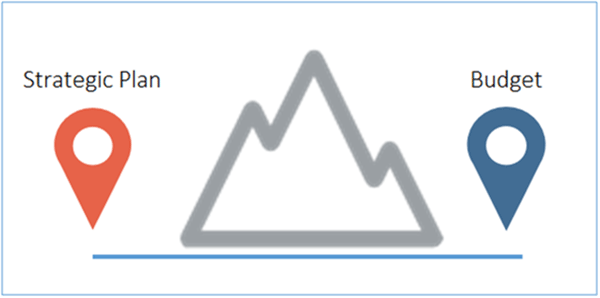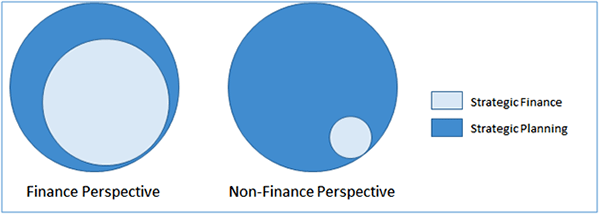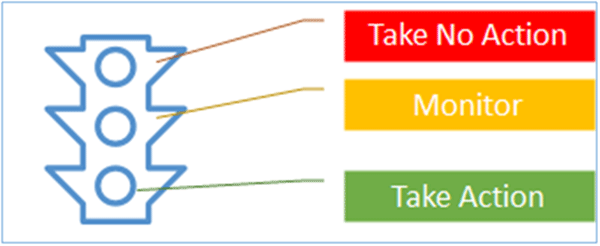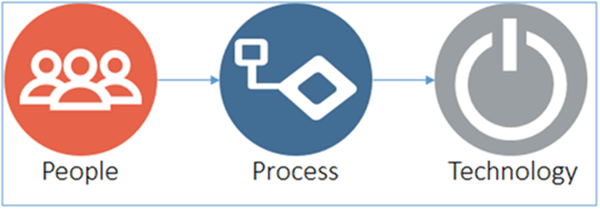How to establish sustainable success in Strategic Finance, one step at a time.
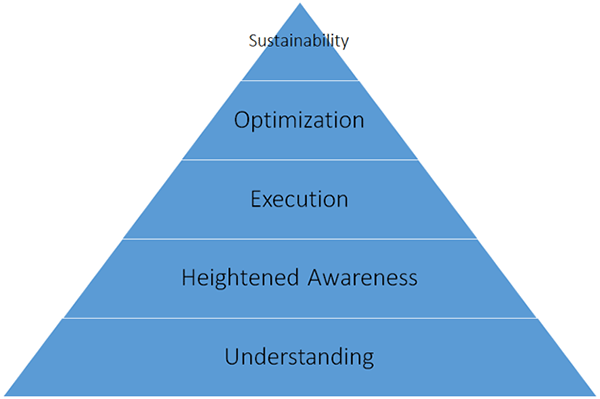
Introduction
As a thought leader in Strategic Finance for the past 15 years, I’ve seen companies greatly improve their Integrated Planning capabilities by adopting a well-defined Strategic Finance process.
When executed correctly, Strategic Finance is the linchpin between Strategic Planning and Budgeting. It helps organizations turn strategic thinking into reality by cascading thoughts and goals into measurable financial outcomes.
In doing so, Strategic Finance eliminates the disconnect that often occurs when individuals work from opposite ends of the planning spectrum and don’t coherently meet in the middle.
In order to understand how Strategic Finance can help your organization’s ability to optimize Integrated Planning, I invite you to self-assess both your individual level of understanding as well as your team’s grasp for Strategic Finance.
What pitfalls and roadblocks could your organization overcome with just a bit more insight into ways in which other organizations have achieved success in Strategic Finance?
Level 1: Establish an Understanding for Strategic Finance
In order to start the process of developing greater competency in Strategic Finance, one has to obviously start by understanding what it is.
Quite literally, Strategic Finance means the long-term (“strategic”) analysis of financial information (“finance”).
In order to put a little more meat on the bone, I prefer the following, more detailed definition:
Strategic Finance is a high-level, target setting exercise that focuses on the analysis of alternative outcomes (scenarios) spanning longer-term time horizons, where Cash Flow is the ultimate unit of measurement.
Strategic Finance can be graphically represented in the following way.
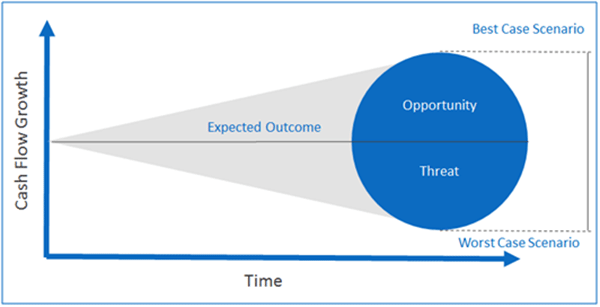
As the graph indicates, the longer the timeframe, the greater the range of potential outcomes there are (made up of both good and bad outcomes). So, regardless of whether you take an optimistic or a pessimistic view of the future, the purpose of Strategic Finance is not to assume a single view of the world, but to have a broader understanding for what is possible in order to set direction and allocate resources.
Some may argue that other financial measurements other than Cash Flow (or perhaps more accurately, the growth in sustainable Free Cash Flow) are applicable but I prefer not to dive into that discussion right now.
Rather, since Strategic Finance is best described as a process for evaluating alternatives, it requires a common financial measurement aided by the use of financial modeling tools that are highly capable of performing three statement modeling (i.e. IS/BS/CF).
Other forms of modeling such as statistical or predictive modeling can be helpful, but should not represent a core element of Strategic Finance as Strategic Finance is about evaluating “real” opportunities and threats that focus less on chance (statistics) and more on defining the goals to be achieved over longer timeframes.
Level 2: Create a Heightened Awareness for Strategic Finance
When it comes to Long-Range planning, we often default to using the term Strategic Planning in favor of Strategic Finance.
So, are they really the same thing?
In corporate planning, I think it serves us best when we recognize Strategic Finance to be a subset of Strategic Planning, where Strategic Finance operates as a testing and validation component to the broader vision of the Strategic Plan.
As Finance people, we tend to see Strategic Finance as a major component of Strategic Planning. Yet, for some organizations and departments, the level of Strategic Finance involvement can be minimal or in many cases nonexistent. This is where the danger lies.
Applying a level of awareness or separation between the two terms will help to solve this problem.
By developing a healthy separation between the two processes, organizations will be better positioned to cut down on ambiguity and put into place better checks and balances by partnering Strategic Planning and Strategic Finance.
We must realize that strategic plans are often written by individuals who are actively trying to influence their peers. Although that should be seen as a good thing, it must also be followed up by robust testing.
When the people in charge of heading the Strategic Plan are also the same people responsible for testing and validating it, the result can often be less than optimal.
This is why it often makes sense to have the Strategic Planning process headed by an executive such as the CEO/COO or the Chief Strategy Officer (CSO) while relying on the FP&A team to manage the Strategic Finance process. This awareness of separation helps to provide both credibility and clarity to the overall outcome.
Level 3: How to Successfully Execute Strategic Finance
For those who have graduated past the awareness level, we can now focus on the successful execution of Strategic Finance within your existing Budgeting and Forecasting process.
Undoubtedly, we’ve probably all seen an Integrated Planning cycle before. They often look something like the diagram on the left.

But let us take that same chart and simply put it on a diet by pinching it in at the middle in order to arrive at a more hourglass looking diagram (see right side). This new image contains the same steps (slightly rephrased) and runs in the same clockwise direction, but now provides a clearer separation for what is really occurring in integrated financial planning, namely the harmonization of top-down (Strategic Finance) and bottom-up (Budgeting & Forecasting) planning.
This separation makes sense because in most cases, the need for large amounts of entity detail runs contrary to the need to simultaneously assess alternative outcomes. This is why most Budgeting and Forecasting exercises focus on establishing a “single version of the truth” while most Strategic Finance models are all about capturing the “big picture”.
This new slimmed-down view makes it much easier to understand the process flow that really occurs in a well-harmonized Integrated Planning environment.
The top-down process starts with the need to capture and evaluate alternative outcomes. Later, these alternative outcomes are then used as part of an evaluation and discussion exercise to ultimately reduce the number of alternatives down to a single actionable strategy.
This strategy is then passed along to the bottom-up budgeting process which goes through a coordinated and controlled process to push out the strategic targets across the entity detail of the business. As time passes, actuals are collected and reforecasts are made at a level that might not be as detailed as the Budget but are certainly still more detailed than the top-down plan. The latest forecast is then consolidated and passed back to Strategic Finance to repeat the cycle again.
This process accurately describes the optimal approach to achieving a well-orchestrated bottom-up and top-down planning process. Yet, perhaps the most interesting observation to make is how small the integration point really needs to be. Too much bulk in this area will almost certainly reduce the overall efficiency of your integrated planning process.
Level 4: How to Optimize Strategic Finance
For those that have moved on past the execution level, we can now focus on the mindset of optimization.
When we think about ways to optimize the Budgeting & Forecasting process, we often equate that to identifying ways to reduce the time spent Budgeting. This is because it is often tedious, involves many people and ultimately takes employees away from doing other activities (namely their job).
However, I think you can make the opposite case when it comes to Strategic Finance.
That is because Strategic Finance is typically a Finance minded activity, performed by a smaller number of users whose interest is focused on working with others in order to analyze growth opportunities and increase shareholder value.
So even though we want to make the process efficient (so we can evaluate a single opportunity quickly), we shouldn’t actually look to reduce the total amount of calendar time spent on Strategic Finance. In fact, we should try to increase it.
By actively evaluating or screening for alternatives, organizations are better able to keep our finger on the pulse of the market. This is because the companies that are better at continuously performing Strategic Finance are likely to be the ones who are able to act quickly when an actual opportunity arises.
Level 5: How to Sustain Excellence in Strategic Finance
Adopting successful Strategic Finance capabilities is a great achievement, but it is now critically important to focus on how to sustain that success for years to come.
Since sustainability is the highest level of competency, it is probably no surprise that it is also the toughest stage to master. Yet, the formula for success is actually quite simple. It involves a good mix of three key ingredients: people, process and technology.
People
Getting the right people involved in Strategic Finance is extremely important, but since that is going to differ quite a bit from organization to organization, I think it is more important to address the collective thinking (culture) that needs to be adopted. In order for Strategic Finance to work, organizations must create an environment that encourages peers to contribute their own unique ideas and suggestions. Gone, are the days of presenting static plans to your peers and forcing them into submission. Rather, we need to promote the efficient discussion and debate of alternatives, so that new ideas can be forged and steadfast plans can achieve the buy-in they deserve.
Process
In order to manage such an environment, FP&A must also adopt a more agile management approach for Strategic Finance. This means that unlike the command and control nature of bottom-up budgeting, FP&A needs to enable peer teams to have more control in shaping what is possible. So in order to achieve this, FP&A must allow modelers to have more control when it comes to things like
- workflow (who and when models are shared),
- metadata (creation of new accounts, entities, scenarios, etc.),
- formulas (new ratios, forecast rules, etc.).
Locking down the model will only act to frustrate and limit modelers from maximizing their Strategic Finance efforts. Forcing users to take their alternative ideas offline goes against the very nature of Strategic Finance.
Technology
If what I’ve explained above sounds difficult to achieve using Corporate Performance Management (CPM) software, then you’re not alone. In fact, most companies continue to rely on spreadsheets for Strategic Finance, regardless of their investments in bottom-up planning tools.
At first glance, spreadsheets eliminate pre-defined workflows and make it possible for modelers to make their own logic changes, but they also introduce a host of issues as well (version control, cell errors and transparency to name a few). Spreadsheets are the ultimate personal productivity tool that addresses ad-hoc needs. But, Strategic Finance is not ad-hoc…rather it is agile (reoccurring as well as ever-changing).
We need to realize that Strategic Finance has unique requirements that are best addressed using purpose-built technology. We need to stop building work-a-rounds and start addressing these concerns head-on. We must not let technology drive our capabilities, but instead select technology that best supports the people and processes that are responsible for driving real change in your organization.



